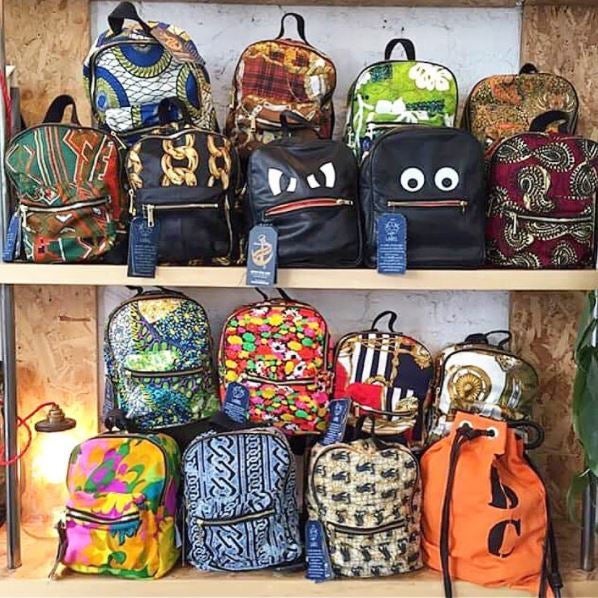
The reuse industry handles 3.8 billion pounds of clothing and textiles every year. While thrift shops give many pre-loved items a new life through reuse, not all unwanted clothing or household goods are able to be resold in their original state to consumers.
Innovators throughout the circular economy focused on reducing, reusing and recycling have developed profitable businesses and industries around these goods. A network of diverse reuse customers – including buyers, scrappers and producers – with unique needs now spans the globe. For instance, at Savers, we sell single shoes to a buyer in Pakistan, torn or stained jeans to converters in India who reconstructs fibers to be used as insulation in homes, children’s soft toys to markets in West Africa and kitchenware to East African buyers.
One of our reuse customers has dedicated his career to transforming unwanted clothing and textiles into fashion forward creations. Meet Steven Bethell, founder of Bank and Vogue and Beyond Retro. You might have seen his merchandise on the cover of British Vogue or worn by several celebrities. Steven has become one of the largest full-service brokers of used goods in North America and one of the largest manufacturers of upcycled clothing in the world. He joined the sustainable fashion world over two decades ago, and has remained dedicated to fighting the crisis of stuff and keeping laundry out of landfills.
What inspired you to start Beyond Retro and Bank & Vogue?
Steven: It all began on Tuesday nights in my neighborhood, which was garbage night. The sheer volume of treasures in the trash made me realize there was an opportunity for reuse.
In a warehouse in Ottawa years later, I saw 20 truckloads of used clothing just stuck there and the company didn’t know what to do with them. It woke me up to how much stuff was out there that had the potential for an extended life. That’s where we saw a chance to make a real impact, and created our recycling brokerage company to recycle these pieces across the world. Now we ship four million pieces of used clothing across the globe each week, finding relevant homes for them and creating a circular economy on a huge scale.
While dealing with large volumes of clothing, we started to see incredible one-off pieces coming through that deserved to be center stage. I remember being blown away by pieces like a 1950s Cowichan sweater, and knew there would be a market for high quality vintage pieces. And so Beyond Retro was born in the heart of East London on Cheshire Street.
Why is it important to source reclaimed materials and upcycle?
Steven: 95% of textiles that end up in landfills could be reused or recycled. When the garment industry generates 100 billion garments a year, we need to find as many different avenues for reusing the materials already in our system. There’s already a plethora of beautiful fabrics out there, from workwear and denim to floral prints, and I believe it's important to reuse these fabrics in innovative ways to make something desirable and fashion forward for our customers.
What’s the most unexpected reclaimed item or material you’ve used for the Beyond Retro LABEL?
Steven: Recently we created a collection of bags made from orange prison outfits. These garments have little to no resale potential, but had exciting upcycling potential. Instead of going into landfills, we created a sustainable, fashionable commodity.
What do you think would make reused, recycled and reclaimed fashion more accessible to the public?
Steven: At Beyond Retro we believe that the product we create must be relevant to our audience. If we create something interesting, one-of-a-kind, functional and on trend, then it makes sustainable fashion accessible and desirable. Plus, the price has to be affordable – a sustainable revolution can only be won if all our customers can come on the journey with us.
From your perspective, where do you see the future of sustainable fashion?
Steven: Bank & Vogue has proven that we can collect, buy and sell used clothes in volume. Beyond Retro has proven that vintage in the UK & Sweden can be part of the fashion landscape. The next stage is making the sustainable option as desirable and accessible to as many different people and demographics as possible, offering an alternative to fast fashion that educates and empowers customers to shop more consciously.
Landfills Aren’t Laundry Piles
Unfortunately, people are still tossing their laundry in the trash. Savers’ State of Reuse Report found that 54 percent of North Americans threw away unwanted clothing or household goods last year. In the U.S alone, that contributes to 26 billion pounds of textile waste annually.
As our global clothing footprint has increased exponentially, circular economy innovators like Steven have pioneered new ways to maximize the potential of every item. Individuals can participate in the circular economy too by donating their unwanted items to charitable organizations, further keeping reusable items out of landfills.
